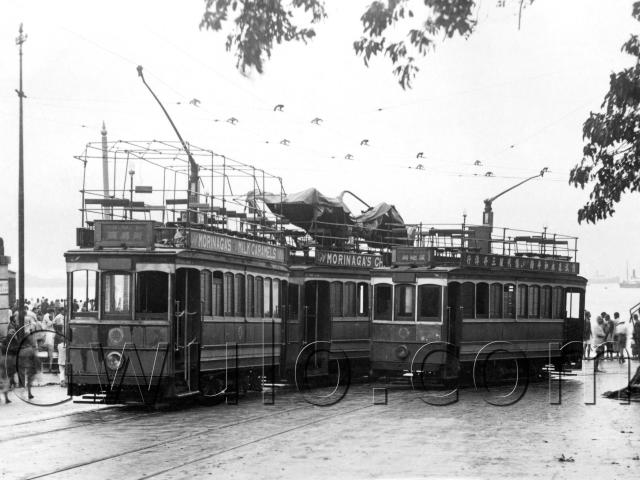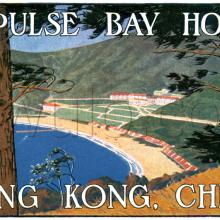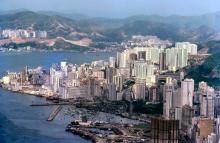What caused the accident?
Something has ripped the roof off the right tram, and its driver's window is smashed (you can see what's left of the roof lying on the ground to the right). The canvas cover from the left tram is nowhere in sight, and the roof and conductor arm on the middle tram are bent out of shape. But what caused all the damage?
One suggestion is that it was a simple collision. The fact that the trams are on a corner makes that a possibility.
But the photo comes from a collection of photos showing typhoon damage, so I wonder if that's what we're looking at here. Certainly the ground looks wet. And the crowd aren't interested in the trams at all, instead they're looking out to sea. Are there sunken ships in the harbour?
Where?
The location is Arsenal Street in Wanchai, roughly opposite where Asian House stands today. At the time of this photo, the Wanchai reclamation and Hennessy Road are still on the drawing board. So trams had to make a sharp left turn from Queen's Road into Arsenal Street, then a sharp right turn from Arsenal Street onto the Praya (the seafront - today's Johnston Road). We're looking at this right turn.
Just out of view to the right was the Soldiers & Sailors Home, and over on the left is the wall at the eastern end of the military land that stretched across today's Admiralty district. There's a crowd of people milling around on the left though, so it seems that the shoreline here was still open to the public?
When?
The trams give us clues. First there's the advertising for "Morinaga's Milk Caramels", and "Morinaga's Ch...". Morinaga, a Japanese confectioner, is still in business today and still sells Milk Caramels and Chocolates, the hidden word on the second tram. According to their website they launched their Milk Caramel product in 1914, so it's later than that.
Then there are the trams themselves. The Tramways website talks us through the generations:
- 1904 – Single-deck trams begin running
- 1912 – An open, upstairs deck is added
- 1918 – A canvas cover is added to the upper deck
That pushes the date of the photo forward to some time after 1918. There's no sign of the Wanchai Reclamation work yet, so I'll guess it was taken around 1920.
[Update: In the comments below you'll see this has been confirmed to be damage from the typhoon in August, 1923.]
Other odds and ends
If you look carefully above the doors, you can see that the class is written there. Downstairs there was a small first class section at the front, and a larger third class section at the back. The easiest way to spot the difference is by the windows: First class gets glass, while third class gets wooden shutters. Wikipedia says that the whole top floor was for first class passengers.
Tram number 56 on the left is signed as heading to Causeway Bay, while the tram on the right is heading west to Whitty Street. The same destinations are still shown on trams today.
Any more information?
I've tried several searches through old newspapers over years 1900-1920: "tram accident", "arsenal accident", "arsenal street". Each search returned several results, but none were relevant to this photo.
I had better luck in the book 'Early Hong Kong Transport' by Cheng Po Hung. On page 231 there's a print that must have come from the same negative, but was cropped to give a wider view. It clearly shows the building on the right, and a wall with gate on the left left. He has titled the photo:
Three damaged trams at the scene of a traffic accident on Arsenal Street, c.1915. On the right is the second "Sailors' Home" (Sailors' Club).
What else can you tell us about this photo?
Regards,
David
Reference: BA002





Comments
Re: What might have caused the accident?
Hi there,
I would speculate....... Something crashed onto the canvas top, breaking the circuit, making the lead tram immobile in mid stride while the second Causeway Bay tram was going to fast and too close (these trams could go up to at least 30 mph if the driver wanted it to). The sand and magnatic breaks could not come up in time and then boom.......
I have no idea about the Whitty Street one, but maybe one of the other two got derailed and they collided at the turn......
Best Regards,
T
re: Tram accident
Thomas, that's an interesting idea. Maybe a branch from the trees, or something from the nearby buildings blew onto that middle tram?
I extended the newspaper search to 1925, but still nothing relevant!
Regards, David
Just my (grandpa's) two cents, or one, or three.
I have nothing to say about the crash, but I wonder if trams looked the same in the 1930s. The only thing about trams that I can recall is that when my grandfather settled in Hong Kong in the mid-1930s, a lower deck tram ride cost 1 cent. If you could afford it, riding on the top cost 3 cents. Of course, a lot of people chose to walk instead.
Re: Tram Accident
Food for thought.
Assuming the photo is part of a collection of typhoon prints, I had looked into the Royal Observatory archives and cross-checked the dates (1914-1920) of significant typhoon events in Hong Kong and the write-ups in the local press of tram accidents.
14 August 1917 HK Daily Press reference:
The photo looks like the aftermath of a typhoon with the crowds milling around the Praya East waterfront perhaps looking at the damaged boats and sampans along the praya wall. The damage to the trams may have occurred somewhere else instead with the trams being taken back to the depot for repairs.
Re: Tram Accident
Moddsey, thanks for digging deeper into this. The set of trams described in the article are a good match for the trams in this photo, aren't they?
Then I wonder if the tramways website is correct with 1918 as the year that canvas covers were introduced. It seems unlikely the top would have blown away without the canvas cover there to offer some resistance to the wind.
Regards, David
Re: Tram Timeline
According to "Early Hong Kong Tramways" by Cheng Po Hung, the following information is provided and supplemented by Hong Kong Tramways Annual Reports:
1904 Single-decker tram service commenced operation.
1912 Second-generation open upper deck tram was introduced.
1913 Third-generation canvas-covered upper deck tram was introduced.
1925 Fourth-generation fully enclosed double-decker tram was introduced. Completion of 1/2 mile double track between Causeway Bay and Shaukiwan (Source: China Mail 27 February 1925
1927 End of 1927, half of the fleet were converted from the canvas curtain arrangement to covered top decks. (Source: China Mail 8 March 1927)
1928 Completion of the double track between Shaukiwan and Taikoo. (Source: China Mail 27 February 1928).
Wikipedia also notes that Hong Kong Tramways once had a storage facility (depot) on Arsenal Street.
1924 Morinaga Advert
1920s Tram Accident
Looks like taken near Wellington Barracks. Perhaps the centre tram in your photo.
Typhoon Damage?
Dear David,
I am currently discussing with Alan Cheung (Vice-chairman of HK Collectors Society and tram expert) on the damage photo shown by moddsey. We also reckon that the damage could be due to a typhoon.
Have you considered the possibility of the 1923 typhoon which brought rather serious damages around the territory, and rather close to your estimated date of 1920? Also, as you mentioned that "the photo comes from a collection of photos showing typhoon damage", would the date of the collection give some further hints?
Cheers, CM
Typhoon Damage - 1923 Typhoon?
Furthermore, a search of newspaper archive at Trove for the 1923 typhoon (http://trove.nla.gov.au/ndp/del/article/45616528) reveals the following:
"The destruction ashore is more extensive than previously thought. Huge trees were rooted up causing serious damage to overhead telephone and other wires. Several motor cars and a few tram cars were wrecked."
Cheers, CM
Typhoon Damage
Hi CM,
The bulk of the photos in that book were from the 1906 typhoon (they're the ones I showed you when we met with Geoff Emerson). But there was also a handful of other, undated, photos in the front of the album (including the one shown above) from several different typhoons. So no help there unfortunately.
It could well have been the 1923 typhoon, but I still can't see anything that gives a firm date.
Does Alan know when the canvas roof went out of service on trams? I've also seen photos of trams with a wooden roof on the upper deck but open sides, and wonder if they were an intermediate generation between the canvas roof and the fully-enclosed upper deck.
Regards, David
Typhoon Damage & Tram Design
Dear David,
Below is advice by Mr Alan Cheung on the tram designs:
"The 1st generation tram started service in 1904-1912 (single deck) then 1912-1918 (open top double deck), 1918-1926 (covered with canvas double deck), from 1926 with wood roof."
Considering Alan's advice, my postulation of damages related to the 1923 typhoon is still consistent.
By the way, when did the Wanchai reclamation start?
Thanks a lot, CM
re: Typhoon Damage & Tram Design
Thanks for the note about Tram dates.
I've just posted some information about the Wanchai reclamation, which started in 1921:
http://gwulo.com/node/19051
Regards, David
Typhoon Damage & Tram Design
Dear David,
Thanks for the information about Wanchai reclamation. Alan just provided some further information about similar photos of damaged trams, from Atkinson's book "Hongkong Tramways" (http://gwulo.com/node/19052). The caption of the photos reads "Canvas-roof cars caught out in a Hong Kong typhoon, about 1928". Perhaps the year 1928 was a bit off, and we are seeing photos from the same event?
Cheers, CM
Re: Typhoon Damage
To narrow down the time frame of the original photo, one would have to have to find out when the tram tracks that curved into Arsenal Street became disused or when the buildings housing the Japanese curio shops e.g. Daibatsu that stood at the western entrance to Queen's Road East were torn down.
Arsenal Street tram tracks
In this c.1930 photo (http://gwulo.com/node/14734), part of the Blue Buildings is still standing, and the tram lines haven't been laid on Hennessy Road, so the Arsenal Street tram line should have gone out of service sometime later than that.
Regards, David
Re: Demolition of Blue Buildings
See http://gwulo.com/node/6488
Typhoon Damage - 1923 Typhoon
Just posted two photos of tram damages (with kind permission of Mr Alan Cheung) at:
http://gwulo.com/node/19683
http://gwulo.com/node/19684
According to Alan, these two photos were stamped "Ming Yuen Studio" dated 1923. The outlook of the damaged trams looked very similar to those posted above, thus probably originated from the same event. And the photos show that the event was not limited to just one or two locations but damages to trams occurred in many places in the Wanchai area. Thus it was very likely due to a significant weather event, viz. the 1923 typhoon.
Furthermore, the date of the photos could also support that the Wanchai reclamation had not yet taken started in 1923.
Further views welcomed.
CM
1923 Typhoon Tram Damage
I think Alan and C M have got the typhoon event correct. Thanks for thier persistence in nailing down the event.
HK Telegraph 18 August 1923
Trees and branches of fair size littered the city where ever trees were growing. One grave danger was the numbers of over-head tram and telephone wires that had been torn down. Many experienced severe electric shocks this way and later the Tramways Company turned off its current everywhere.
Trams were stopping off along all the routes with their canvas roofs ripped of. Opposite the naval yard, tram No. 25 had the whole top wrecked by the falling of a big branch across it.
My typhoon tram photos also come from 1923 and tram no. 25 has been identified as the tram that came to a halt or grief opposite the Naval Yard.
Note the overhead cable ropeway from Victoria Barracks to Arsenal Yard.
As for the Praya East Reclamation, the reclamation had begun in 1921 with the demolition of Morrison Hill. Given the slow rate of progress, the western end of the Praya East reclamation had not been filled in yet in 1923. Hennessy Road only appeared in 1929, thus the tram tracks that we see today from the western end of Hennessy Road to Johnston Road was laid down later.
canvas roof
Canvas roof were fitted on earlier single deckers and latter new open-top double deckers. It's difficult to outline the out of service date of the canvas roof/wooden roof trams as they were gradually rebuilt to fully-enclosed as well as lack of official record.
Regards, Joseph
amended dates
Regarding the dates on the modifications of the double deckers (canvas-roofed and wooden-roofed) commented above, we have revised in the new edition of the Atkinson & Williams book.
Regards, Joseph
Tram 56
56 was constructed in 1923 and the pictured trams were without side destination screens which did not applied until 1927.
Regards, Joseph
Side destination screens - 1927 & after
Thanks Joseph, that's another good trick to help date photos.
Regards, David